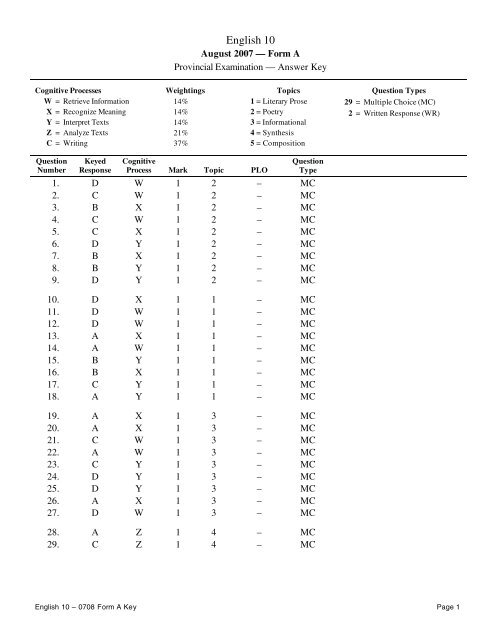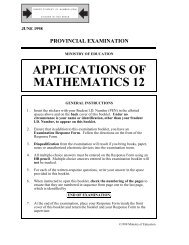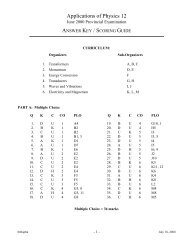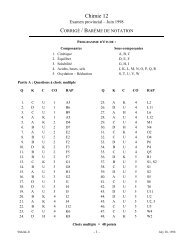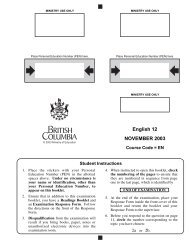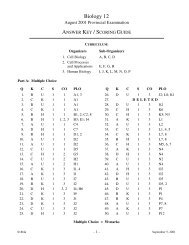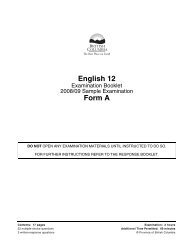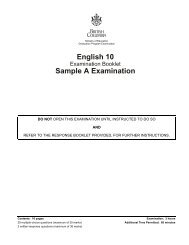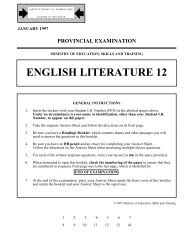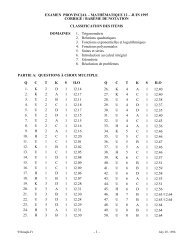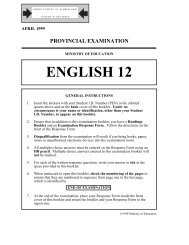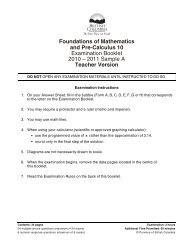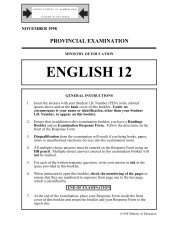English 10 - QuestionBank.CA
English 10 - QuestionBank.CA
English 10 - QuestionBank.CA
Create successful ePaper yourself
Turn your PDF publications into a flip-book with our unique Google optimized e-Paper software.
<strong>English</strong> <strong>10</strong><br />
August 2007 — Form A<br />
Provincial Examination — Answer Key<br />
Cognitive Processes<br />
W = Retrieve Information<br />
X = Recognize Meaning<br />
Y = Interpret Texts<br />
Z = Analyze Texts<br />
C = Writing<br />
Weightings<br />
14%<br />
14%<br />
14%<br />
21%<br />
37%<br />
Topics<br />
1 = Literary Prose<br />
2 = Poetry<br />
3 = Informational<br />
4 = Synthesis<br />
5 = Composition<br />
Question Types<br />
29 = Multiple Choice (MC)<br />
2 = Written Response (WR)<br />
Question<br />
Number<br />
Keyed<br />
Response<br />
Cognitive<br />
Process Mark Topic PLO<br />
Question<br />
Type<br />
1. D W 1 2 – MC<br />
2. C W 1 2 – MC<br />
3. B X 1 2 – MC<br />
4. C W 1 2 – MC<br />
5. C X 1 2 – MC<br />
6. D Y 1 2 – MC<br />
7. B X 1 2 – MC<br />
8. B Y 1 2 – MC<br />
9. D Y 1 2 – MC<br />
<strong>10</strong>. D X 1 1 – MC<br />
11. D W 1 1 – MC<br />
12. D W 1 1 – MC<br />
13. A X 1 1 – MC<br />
14. A W 1 1 – MC<br />
15. B Y 1 1 – MC<br />
16. B X 1 1 – MC<br />
17. C Y 1 1 – MC<br />
18. A Y 1 1 – MC<br />
19. A X 1 3 – MC<br />
20. A X 1 3 – MC<br />
21. C W 1 3 – MC<br />
22. A W 1 3 – MC<br />
23. C Y 1 3 – MC<br />
24. D Y 1 3 – MC<br />
25. D Y 1 3 – MC<br />
26. A X 1 3 – MC<br />
27. D W 1 3 – MC<br />
28. A Z 1 4 – MC<br />
29. C Z 1 4 – MC<br />
<strong>English</strong> <strong>10</strong> – 0708 Form A Key Page 1
Question<br />
Number<br />
Keyed<br />
Response<br />
Cognitive<br />
Process Mark Topic PLO<br />
Question<br />
Type<br />
30. – Z 12 4 – WR<br />
31. – C 24 5 – WR<br />
<strong>English</strong> <strong>10</strong> – 0708 Form A Key Page 2
<strong>English</strong> <strong>10</strong><br />
August 2007 — Form A<br />
Provincial Examination — List of Possible Responses<br />
30. Who would be the better role model, Marilyn Bell Di Lascio or Sharon Wood?<br />
In making your argument, you must discuss both passages.<br />
(12 marks)<br />
Both women serve as role models in a number of ways. Although they are particular role<br />
models to women and athletes, their accomplishments reveal aspects of their character,<br />
which are equally inspirational to anyone. Students may present that either one or both<br />
may make effective role models. Students may also choose to present an argument that<br />
neither is an effective role model.<br />
Students may make direct or indirect reference to these points for textual support.<br />
These points are a guideline only. Use the holistic rubric to assess the student response.<br />
Marilyn Bell Di Lascio<br />
Positive rode model:<br />
• overcame fear (par 1, 2, 9, 14)<br />
• trusted others “Gus just looked me in the<br />
eye and said…‘I will find you’” (par 2)<br />
• determined (par 3 and 5)<br />
• realistic (par 6)<br />
• patriotic (par 13)<br />
• appreciative of the support of others<br />
(par 21 and 26)<br />
• acknowledges influences/values of others<br />
(par 24)<br />
• modest about her fame (par 22)<br />
• Marilyn did something no other woman<br />
had done before.<br />
• Marilyn’s victory is a triumph for her<br />
country.<br />
Negative role model:<br />
• fearful (par 2 and 5)<br />
• lacks confidence (par 9)<br />
• dependent on others<br />
Sharon Wood<br />
Positive role model:<br />
• overcame fear (par 1 and 2)<br />
• strong physically (par 3 and 4)<br />
• appreciative of the support of others<br />
(par 8)<br />
• conscientious (par 14)<br />
• caring (par 19)<br />
• uses her fame to create the school and help<br />
others<br />
• determined–she forced herself to keep<br />
going when she was delirious<br />
(par 11 to 13)<br />
• perserverance (par 16)<br />
• self-discipline (par 16)<br />
• strength of emotions (par 11)<br />
• acknowledges her own limitations and<br />
faults (par 19)<br />
Negative role model:<br />
• abandons her partner (par 11)<br />
• had doubts<br />
Note: Students who do not discuss both passages will receive a maximum scale point of 4.<br />
However, students should not be penalized for focusing predominantly on one passage.<br />
Note: Other answers are possible.<br />
<strong>English</strong> <strong>10</strong> – 0708 Form A List of Possible Responses — CONFIDENTIAL Page 1
Making Connections Through Reading<br />
Written-Response Rubric<br />
Demonstrates an insightful understanding of the texts at an interpretive level. May make inferences. May<br />
show understanding of literary techniques appropriate to genre. Support, explicit or implicit, is thoughtful and<br />
well-integrated. Despite its clarity, response need not be flawless.<br />
Demonstrates a clear understanding of the texts at an interpretive level. May show understanding of literary<br />
techniques appropriate to genre. Support, explicit or implicit, is convincing and relevant.<br />
Demonstrates some understanding of the texts at an interpretive level. Response is organized and<br />
straightforward, but may miss subtle or complex ideas. Supported by relevant details from the texts.<br />
Demonstrates some understanding of the texts at a literal level. Response may be unclear, incomplete or lack<br />
detail. Ideas are often developed unevenly. Support may consist of long references to the texts which are not<br />
clearly connected to the central idea.<br />
Demonstrates a misreading or significant misunderstanding of the texts. Response may be incomplete or<br />
restatements of texts. Support is absent or flawed, with little evidence of relationships or connections.<br />
Demonstrates a misreading or significant misunderstanding of the texts. Response may be irrelevant. No<br />
evidence of support or connections between ideas. May be too short to meet the requirements of the question.<br />
Makes no attempt to address the topic or simply restates the question.<br />
6<br />
5<br />
4<br />
3<br />
2<br />
1<br />
0<br />
Note: This is a first-draft response and should be assessed as such.<br />
The response is to be assessed holistically.<br />
Writing conventions are to be considered only to the extent that they impede meaning.<br />
A variety of types of responses such as graphic representations, tables or lists are acceptable<br />
and shall be assessed according to the rubric.<br />
Students who do not discuss both passages will receive a maximum scale point of 4.<br />
This scoring rubric is derived from the BC Performance Standards for Reading.<br />
<strong>English</strong> <strong>10</strong> – 0708 Form A List of Possible Responses — CONFIDENTIAL Page 2
Writing Rubric<br />
Ideas are fully developed and supported. Accomplishes the purpose with some originality, individuality or<br />
maturity. Effective word choice and sentence variety. Voice and tone engage the audience throughout.<br />
Structure is logical and the writing as a whole may appear effortless. Errors are not distracting.<br />
6<br />
5<br />
Ideas are well-developed and supported. Has a clear sense of purpose. Appropriate word choice and sentence<br />
variety. Voice and tone generally engage the audience. Structure is logical and the writing demonstrates<br />
control. Errors are not distracting.<br />
Ideas are generally straightforward and clear, with some support and sense of purpose. Basic vocabulary,<br />
some sentence variety. Attempts to engage the audience, but lacks a consistent voice. Structure may be<br />
formulaic. Errors generally do not impede meaning.<br />
Ideas are often listed or developed unevenly, with little support or sense of purpose. Limited vocabulary and<br />
sentence variety. Lacks a sense of audience and voice. Structure may be weak. Errors may distract and<br />
impede meaning.<br />
Ideas are often broad generalizations with little support, and no clear purpose. Colloquial vocabulary, weak<br />
sentence structure. Writing reflects little understanding of language conventions. Inappropriate tone or<br />
language for audience. Structure may seem illogical. Frequent noticeable errors interfere with meaning.<br />
Ideas are not developed. Has no discernible purpose. May be too brief to accomplish the task. Lacks<br />
structure. Frequent serious errors.<br />
No attempt to address the topic or is a restatement of the topic.<br />
4<br />
3<br />
2<br />
1<br />
0<br />
Note: This is a first-draft response and should be assessed as such.<br />
The use of paragraph structure should be assessed holistically with reference to the clarity<br />
of organization and expression.<br />
The connection to the topic may be explicit or implicit.<br />
This scoring rubric is derived from the BC Performance Standards for Impromptu Writing.<br />
<strong>English</strong> <strong>10</strong> – 0708 Form A List of Possible Responses — CONFIDENTIAL Page 3


